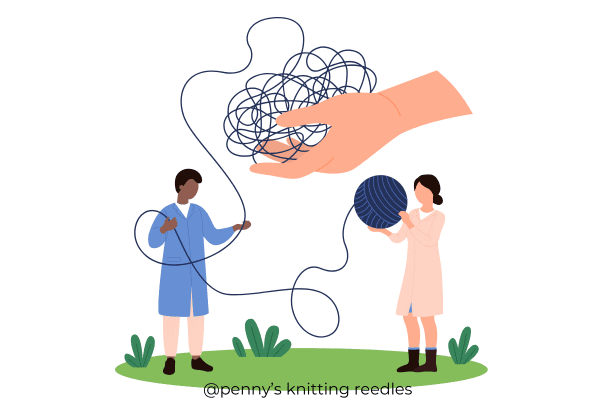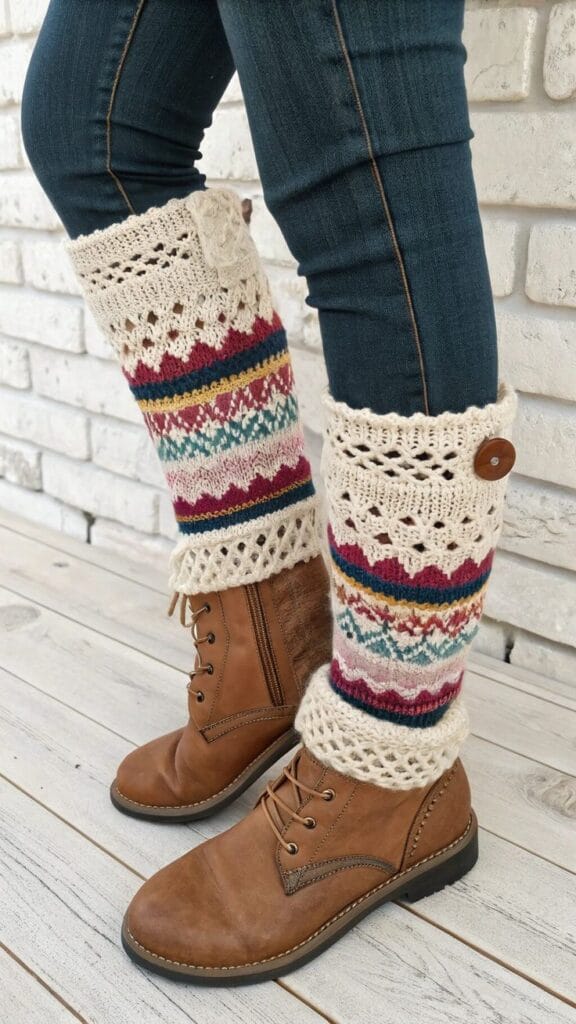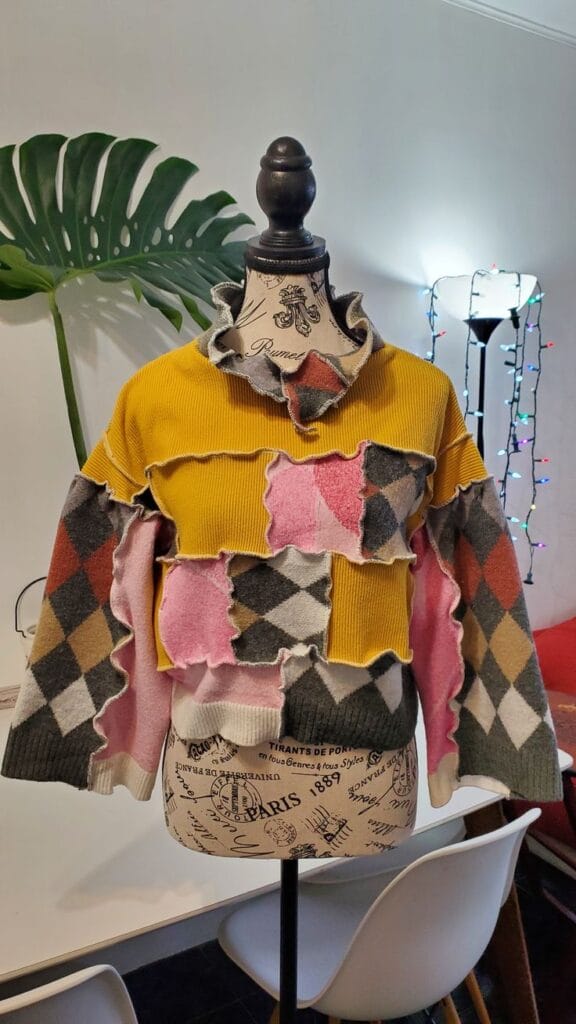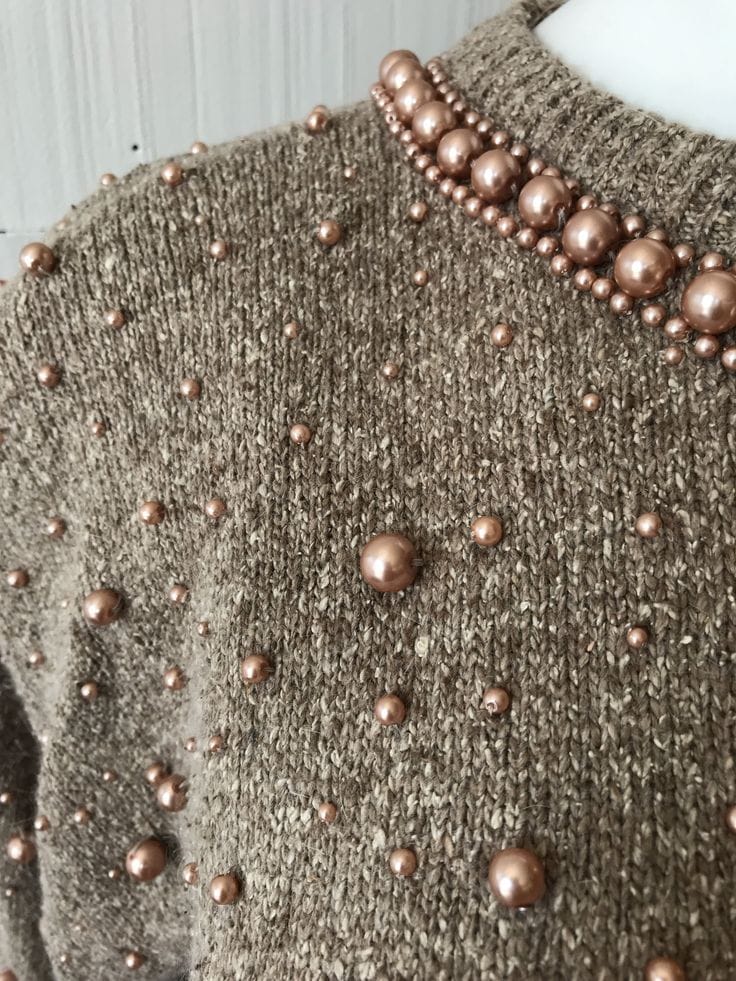Is your closet cluttered with old, out-of-style sweaters that never seem to see the light of day?
Don’t toss them out just yet!
Upcycling and reusing these garments can save money, reduce waste, and create unique pieces that reflect your style.
In this post, we’ll explore how to unravel yarn and felt wool and refashion sweaters into everything from mittens to pillow covers—all while reducing our environmental footprint.
1. Why Upcycle Sweaters?
- Eco-Friendly & Budget-Savvy: Reusing knit fabric and yarn prevent them from ending up in landfills, and you’ll skip buying brand-new materials.
- Creative Expression: Old sweaters offer a wealth of textures and fibers to experiment with.
- Unique, Personalized Items: Your upcycled creations will stand out, ensuring no one else has the same piece.
By giving unwanted knitwear a new lease on life, you’ll enjoy the satisfaction of sustainability and style—all in one go.
2. Gathering Supplies & Assessing Sweaters
Choosing the Right Sweaters
- Fiber Content:
- Wool or Wool-Blends are ideal for felting.
- Cotton, Acrylic or Mixed Fibers work best for unraveling or basic refashioning.
- Condition Check:
- Small holes can be worked around or used for patchwork.
- Large stains might require dyeing or strategic cutting.
Basic Tools & Notions
- Sharp Scissors: Essential for cutting panels or removing seams.
- Seam Ripper: Useful for carefully dismantling sweater sections.
- Measuring Tape, Pins, and Thread: Aids in accurate measuring and sewing.
- Yarn Needles, Crochet Hooks, or Sewing Machine (optional): Depending on the project approach.
Prep Work
- Wash & Dry: Follow care labels. If you plan to felt, use hot water and agitation.
- Color Test: If you’re repurposing fiber, check for color bleed by doing a small sample wash.
3. Unraveling for Yarn

When to Unravel
- Sweaters Knit in Panels: Look at the seams—if they appear hand-sewn or chain-stitched, unraveling is simpler.
- Avoid Serged Seams: The sweater may not unravel cleanly if edges have been cut and overlocked.
- Fiber Value: Check if the yarn is high-quality wool, cotton, or a desirable blend.
The Unraveling Process
- Identify a Seam: Use a seam ripper to open the seam carefully.
- Unwind & Wind: Gently pull the yarn while rolling it into a ball or hank.
- De-Kink the Yarn: Soak in lukewarm water, then hang to dry if the yarn is very crimped.
Project Ideas for Reclaimed Yarn
- Scarves or Hats: Perfect for smaller yardages or color-blocking with multiple reclaimed yarns.
- Amigurumi: Reclaimed yarn can be great for crocheted soft toys, adding a rustic charm.
- Combine with New Yarn: If you’re short on yardage, mix old yarn with new for stripes or colorwork.
4. Felting Old Sweaters
Why Felt?
- Durability & Warmth: Felted wool becomes thick, dense, and less prone to unraveling.
- Soft, Uniform Look: Perfect for coasters, potholders, or sturdy bags.
- Easy to Cut & Shape: Felt edges won’t fray like regular fabric.
Felting Process
- Hot Wash & Agitation: Place the wool sweater in a washing machine set to hot water and a normal or heavy cycle.
- Monitor Shrinkage: Pause periodically to check progress; over-felting leads to a smaller, denser fabric than intended.
- Shape & Dry: Smooth or pin the felted piece to the desired shape, then air-dry flat.
Felting Project Ideas
- Tote Bags: Sew or crochet around the felted panels to create sturdy sides.
- Laptop Sleeves, Coasters, or Potholders: The dense texture protects surfaces and offers insulation.
- Appliqué Shapes: Cut out decorative motifs (flowers, leaves) to sew onto other projects.
5. Simple Sewing / No-Sew Conversions

Sweater to Pillow Covers
- Cutting Panels: Measure your pillow form; cut the sweater front/back to slightly larger dimensions.
- Closure Options:
- Zipper: Insert along one edge.
- Envelope Fold: Overlapping back panels for an easy slip-on cover.
- Finishing Seams: Use a sewing machine or hand-stitch; minimal finishing if edges are stable.
Sweater Mittens / Gloves
- Trace & Cut: Draw mitten shapes onto the sweater fabric; keep the ribbed hem for cuffs if desired.
- Sew Edges: Sew inside out, then flip right side out.
- Add Lining (optional): Use fleece or leftover sweater scraps for extra warmth.
Cozy Leg Warmers / Boot Cuffs
- Repurpose Sleeves: The sleeve’s circumference often fits calves.
- Hemming: Finish the raw edge with a quick zigzag or fold-over hand-stitch.
- Decorate: Add buttons or lace trim at the top for style.
6. Advanced Refashioning Projects

Sweater to Cardigan
- Cutting Open: Carefully cut the front center line of a pullover.
- New Edges: Add a button band, bind with bias tape, or crochet around edges for stability.
- Design Variations: Insert a zipper or decorative closures instead of buttons.
Patchwork Sweater Remakes
- Mixed Sweater Panels: Combine different sweater pieces for a color-block or mosaic effect.
- Serging or Zigzag: Use a sturdy stitch to piec multiple knit fabrics.
- Coordinate Colors & Textures: Achieve a cool patchwork vibe without it looking too random.
Kids’ Wear & Accessories
- Downsizing: Convert adult sweaters into child-sized pullovers or cardigans.
- Plush Toys: Sew stuffed animals from felted wool squares—great for leftover scraps.
- Bonus: Kids love custom pieces they can help design or decorate.
7. Decorating & Embellishing

Embroidery & Appliqué
- Surface Embroidery: Stitch designs directly on the sweater or use felted shapes for an appliqué effect.
- Contrast Threads: Eye-catching details when you use bright embroidery floss on a neutral sweater base.
Dyeing & Painting
- Natural Fiber Sweaters: Great for dyeing if you want an entirely new color.
- Fabric Paint or Stenciling: For bolder graphic patterns—especially on heavier knits.
Adding Trims
- Lace or Ribbon Edges: Attach to the hem or sleeves for a feminine look.
- Buttons & Beads: Spice up plain knit surfaces or create interesting closures.
- Crochet Borders: If you’re skilled in crochet, add a decorative scallop or picot edge.
8. Tips for Success & Sustainability
Trial & Error
- Test Small: Experiment with thrifted or cheaper finds before cutting into a beloved sweater.
- Embrace Imperfections: A little quirk or asymmetry can add character.
Eco-Friendly Approach
- Minimal Waste: Save leftover scraps for stuffing pillows or small craft projects.
- Repurpose Packaging: Transport or gift your upcycled items in reusable cloth bags.
Stay Inspired
- Pinterest & Ravelry: Endless pattern ideas and communities dedicated to upcycling.
- Mix Fabrics: Combine sweater panels with denim, linen, or flannel for unique textures.
9. Conclusion
Recap the Joy of Upcycling
Turning old sweaters into fresh, functional items is:
- Budget-Friendly
- Environmentally Conscious
- Creatively Fulfilling
Whether you unravel yarn, felt for sturdier fabric, or refashion a pullover into a new statement piece, you’re actively preventing waste while honing your craft skills.
Share Your Projects
- Post photos of their upcycled creations on social media with a unique hashtag (#SweaterUpcycle, #DIYKnitRefashion).
- Seek Feedback: Invite comments about favorite transformations or lessons learned.
Final Thoughts
Upcycling old sweaters offers endless possibilities—from reclaimed yarn to cozy mittens or chic pillow covers.
You’ll reduce textile waste, discover new crafting skills, and enjoy the satisfaction of turning something neglected into a treasured and stylish piece.
So, dig through that sweater pile, grab your scissors or seam ripper, and let your imagination and eco-friendly spirit guide you to your next upcycled masterpiece!
